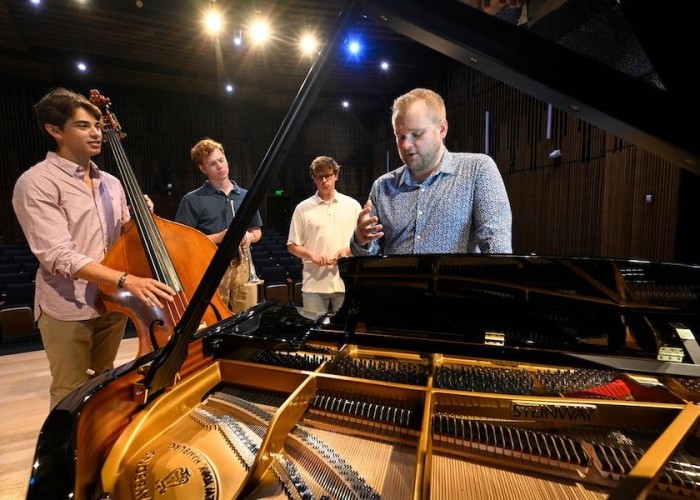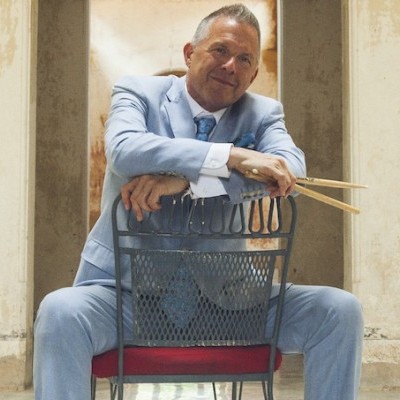Oct 28, 2025 10:47 AM
In Memoriam: Jack DeJohnette, 1942–2025
Jack DeJohnette, a bold and resourceful drummer and NEA Jazz Master who forged a unique vocabulary on the kit over his…

Ryan Middagh, at piano, leads class at Vanderbilt.
(Photo: John Amis)High school seniors interested in studying jazz at the collegiate level have undoubtedly begun investigating a variety of collegiate music school programs around the country. Once they’ve been accepted into a jazz studies program, what can these students expect at their chosen schools — both before and after they arrive on campus? What are jazz studies programs doing to provide a welcoming, immersive environment for their incoming students?
DownBeat talked to faculty members at four prestigious jazz studies programs: Indiana University’s Jacobs School of Music, The New School in Manhattan’s School of Jazz and Contemporary Music, San Francisco Conservatory of Music’s Roots, Jazz and American Music program, and Vanderbilt University’s Blair School of Music. Here’s a look at how each of these schools works to help new jazz studies students fit in smoothly on campus — and how to address student anxieties about fitting into their new campus environments.
Thomas Walsh, chair of jazz studies at Indiana University’s Jacobs School of Music, recalled his freshman year at Indiana in the mid-1980s before addressing the current efforts in place at Jacobs to make the transition to college easier for incoming students.
“As a freshman at Indiana, that week before classes started seemed like the longest week of my life,” he recalled. “You’re just waiting for everything to get started and feel it’s never going to happen. There’s also the anxiety of wondering how you’re going to fit in, and how your playing compares to everyone else’s. But things have changed quite a lot since then for incoming students, and by the time they arrive on our campus for classes, they’ve already gone through the interview, audition and the pre-screening process on voice, sax, guitar and drums.”
Although Jacobs’ Jazz Studies department doesn’t have a fixed orientation-week process, Walsh and the faculty make sure certain events are always on the schedule.
“During that week we hold two jam sessions,” he explained. “These opportunities for new students to come and meet each other and play — as well as to meet and play with returning students in an informal, fun setting is a great community-building exercise. It helps break the ice on every level. It also gives them the opportunity to do something they’ve specifically come here for — to play jazz. And by playing with other students, they realize they’re going to fit in well with a great cohort of people.
“On the Sunday of that final week before classes begin, incoming students participate in ensemble auditions. At the end of the first day of classes on Monday we hold a convocation to share info and expectations. Everyone introduces themselves so they all get a sense of the range of places people come from. We also let them know about jam sessions we book at the Vault Club on campus. It’s a nice space with a great vibe. By the end of that first week before classes and the convocation, everyone is settled in.”
Keller Coker, dean at the School of Jazz and Contemporary Music at Manhattan’s New School, explained that once a new student has been accepted and paid their deposit at the New School, registration begins immediately — from scholarship opportunities, housing arrangements and improvisation, composition and music technology placement exams to selection of classes and private instruction faculty.
“By the time the students get here for orientation week before classes start, our academic teams have worked with them to go through everything they need to finish registration by early August,” said Coker. “And in the month of July, only incoming students can register for classes. We don’t want them to get shut out. We also have a staff person who works with students to help them choose the faculty musician they want to work with — like Alison Miller or Matt Wilson for a student drummer.”
The weekend before orientation week, students arrive to move into dorms. Starting on Monday, they participate in jam sessions throughout the week, and attend an introductory ceremony to go over what they can expect when classes start.
“Orientation week is great,” said Coker. “The new students move into dorms in the greatest jazz neighborhood in the world, the West Village. Then they start orientation, and we have jam session for everyone that wants to play. We also host a singer/songwriter gathering. The new students start to get to know one another, and at the end of the week all students — undergrad and grad — get together for an introductory ceremony. Then we get the jazz and contemporary music students together and go over what they can expect when classes start, including elective ensembles.
“The school runs about 90 unique ensembles, he added. “Faculty talk about the different ensembles they’re leading and what musician or style each ensemble focuses on. It gives students a way other than looking through the catalog to find out details about the ensembles. A student might be really interested in a Miles Davis electric ensemble, but might miss it in the catalog. We’re there that day to talk with them and answer their questions.”
Jason Hainsworth, executive director of the Roots, Jazz and American Music program at the San Francisco Conservatory of Music, is excited about recent efforts to make the program more applicable to the specific demands of life as a professional jazz musician.
“Our Conservatory was founded more than a century ago, so we took a look at some of the procedures and curriculum in place to see what was working for our jazz students,” said Hainsworth. “One of our major changes is in the way we approach ensembles. We’re a small school in terms of enrollment. We know everyone admitted here can really play. So we mix up ensembles by including freshmen with our returning students. That eliminates the cliquishness that can be part of music programs. And it reinforces the idea of community — that we’re all in this together.
“We give everyone a few minutes with their new band to select three to four tunes from a list of standards we’ve sent them,” he explained. “When they play it’s a great way to see how they react with each other — musically and otherwise. It creates a more relaxed culture and environment and makes freshmen think, ‘I’m with the grownups now. I better step up my game and hone my craft.’ It also makes it much more realistic to the environment of a professional jazz musician.”
In addition to making sure theory and composition classes are taught with a jazz — rather than classical — focus, semester concert performances are approached differently as well.
“We don’t have end-of-semester concerts,” said Hainsworth. “But every semester there are at least four student and faculty side-by-side concerts with a three-day residency format. Students bring in original compositions and arrangements they’ve been working on and get feedback from faculty about what actually works for the set from a programming standpoint. That feedback and the mentorship students receive rehearsing and playing with the faculty is a more real-life experience for them. In addition, some of our concerts take place at SFJAZZ, and the musicians there treat our students as young musicians and as part of jazz community.”
Ryan Middagh, chair of the Department of Jazz and Global Music at Vanderbilt University’s Blair School of Music, has seen several changes in the process of working to successfully immerse new jazz students into Blair, Vanderbilt and the ever-growing Nashville music scene over the past decade.
“There are several things unique about Blair,” explained Middagh. “We’re an undergraduate-only school, so that allows us to make sure all our students are taught by faculty, not graduate students. And since we’re part of a Top 10 university, all applicants to Blair also must be admitted to Vanderbilt. That makes the audition and pre-screening process rigorous, but with our limited enrollment of 250, Blair can provide an excellent musical experience with the option of exploring other fields — in a welcoming community environment.”
Like other top music schools, Blair has video pre-screening and in-person audition requirements. With Blair’s enrollment limit, the process is a pathway to finding students who, according to Middagh, are “thoughtful, mature and talented students who can really take advantage of what we have to offer.”
When accepted jazz students arrive on campus for orientation, they participate in Vanderbilt Visions, a program that places them in a group of 20 fellow first-year students with different majors and interests, and that meets throughout the first semester. In addition, jazz studies students also participate in SEQUE, a Blair Music School program led by a music student mentor that also continues through the first school year.
“It’s all about making sure we build an on-ramp to a successful experience at Vanderbilt and Blair,” added Middagh. “It’s part of a combination of small group activities and larger events throughout orientation and the school year to build strong connections both within Blair as well as the university for our new students.
“And, of course, we have jam sessions. They officially don’t start until the first day of classes, but it’s a big thing. Sunday night, Rudy’s Jazz Club has an all-ages jam. Students even ask to borrow my office for jam sessions.
“The Nashville music scene is part of my syllabus for students as well,” he added. “Nashville has all these great recording studios. So instead of recording on campus, I’ll take students to studios around town. It’s educational, and they also learn the process of playing in a studio as a professional.” DB

Jack DeJohnette boasted a musical resume that was as long as it was fearsome.
Oct 28, 2025 10:47 AM
Jack DeJohnette, a bold and resourceful drummer and NEA Jazz Master who forged a unique vocabulary on the kit over his…

Always a sharp dresser, Farnsworth wears a pocket square given to him by trumpeter Art Farmer. “You need to look good if you want to hang around me,” Farmer told him.
Sep 23, 2025 11:12 AM
When he was 12 years old, the hard-swinging veteran drummer Joe Farnsworth had a fateful encounter with his idol Max…

D’Angelo achieved commercial and critical success experimenting with a fusion of jazz, funk, soul, R&B and hip-hop.
Oct 14, 2025 1:47 PM
D’Angelo, a Grammy-winning R&B and neo-soul singer, guitarist and pianist who exerted a profound influence on 21st…

Kandace Springs channeled Shirley Horn’s deliberate phrasing and sublime self-accompaniment during her set at this year’s Pittsburgh International Jazz Festival.
Sep 30, 2025 12:28 PM
Janis Burley, the Pittsburgh International Jazz Festival’s founder and artistic director, did not, as might be…

Jim McNeely’s singular body of work had a profound and lasting influence on many of today’s top jazz composers in the U.S. and in Europe.
Oct 7, 2025 3:40 PM
Pianist Jim McNeely, one of the most distinguished large ensemble jazz composers of his generation, died Sept. 26 at…